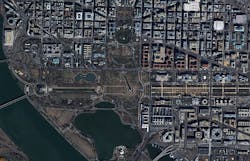U.S. intelligence analysts approach industry for computer 3D models based on satellite imagery
Officials of the U.S. Intelligence Advanced Research Projects Agency (IARPA) in Washington will brief industry from 9 a.m. to 5 p.m. on 30 March 2016 concerning details of this program, called CORE3D. Briefings will be in the Washington, D.C. area.
U.S. intelligence experts need global situational awareness as well as military, intelligence, and humanitarian mission planning that involves timely access to geospatially accurate 3D object data, IARPA officials say.
The CORE3D program has two aims: automated ways to create timely 3D models that capitalize on spectral, textural, and dimensional information from satellite data; and automated ways to recognize and understand objects in satellite reconnaissance data.
The manmade objects that the CORE3D program will model are invariant and relatively large, such as buildings, roads, walls, bridges, towers, dams, or other static structures.
Related: Geospatial imagery is essential
The program will use simplified 3D representation such as constructive solid geometry (CSG), where 3D shapes are built from Boolean operations on simple shape primitives such as cubes, cylinders, or spheres to fit and store the geometry of 3D models. IARPA experts will provide a core library of 3D shape primitives will be provided to all performers.
The CORE3D program focuses on wide area manmade object recognition and scene understanding. Proposed methods shall demonstrate that they can automatically recognize, tag, and update pre-defined object categories from satellite imagery.
Similar to the targets of the physical models, the object categories for functional modeling shall consist of static structures such as communication towers, airfields, power plants, water towers, lighthouses, schools, and hospitals.
IARPA researchers want industry to develop customized learning frameworks optimized for satellite imagery and multi-modal data fusion. Researchers particularly are interested in hybrid approaches that do not rely on just one computer vision or learning modality.
Related: Simthetiq delivers high-end 3D visual models for Fidelity next-gen training solutions
Researchers are interested in satellite panchromatic, multispectral, point clouds, and maps; multi-level fusion to include data level, feature level, and decision level fusion; object level segmentation and classification; point cloud generation from multi-view satellite images; representations of complex scene geometry; accurate 3D model fitting and statistical inferencing; a deep learning framework optimized for satellite imagery scene recognition; and hybrid image understanding module using deep learning, traditional, and new image-understanding algorithms.
Companies interested should register for the CORE3D industry briefings no later than 23 March 2016 online at www.signup4.net/Public/ap.aspx?EID=IARP64E.
The unclassified morning session will include an overview of the program goals, technical challenges, and expected participation requirements. The afternoon will include unclassified presentation and poster sessions for attendees to present their organizations' capabilities and to explore teaming arrangements.
Email questions or concerns to [email protected]. More information is online at https://www.fbo.gov/notices/d84464082e32a0567bde08ea38d5042a.
